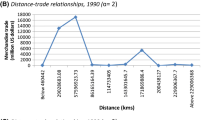Summary
This paper presents results of empirical investigations into the spatial structure of world trade. A cluster approach to measure the integration of various countries through international trade is being used for analysing world trade matrices for several years since 1968. This approach has earlier been applied for the OECD countries and proved to be successful.
Our study was inspired by the work of Andreas Predöhl (Predöhl 1971). In Predöhl’s view the spatial structure of international trade reflects a spatial order of the world economy which developed during the period of industrialization and the basic pattern of which still exists. Our empirical findings indicate that four world regions form integration areas and/or trade blocs of higher intensity in 1983: Western Europe, the COMECON countries, USA/Canada/ Mexico, and Southeast Asia.
We also tried to gain some insight into the causes of the observed spatial order of the world economy. In this context we present empirical estimates based on a doubly constrained gravity model. The results clearly show the influence of the distance factor (in the broadest sense), of adjacency, and of integrative effects of the EEC, the EFTA and some other preferential trading areas.
Finally, we add some remarks on regionalization as an economic rather than a political phenomenon.
The empirical work referred to in section III of this study was conducted by Thomas Brünger and is documented in: Brünger, Peschel 1986, 1987.
Section IV contains results of a trade model estimated by Herold C. Rohweder. They are documented in detail in: Rohweder 1987.
Access this chapter
Tax calculation will be finalised at checkout
Purchases are for personal use only
Preview
Unable to display preview. Download preview PDF.
Similar content being viewed by others
References
Beckerman, Wilfred, (1956), Distance and the Pattern of Intra-European-Trade, Review of Economis and Statistics 38, pp. 31–40.
Bröcker, Johannes, (1980), An Application of Economic Interaction Models to the Analysis of Spatial Effects of Economic Integration, Environment and Planning, Vol. 12, pp. 321–338.
Bröcker, Johannes, (1984), Interregionaler Handel und ökonomische Integration,Schriften des Instituts für Regionalforschung der Universität Kiel, Vol. 6, München.
Brünger, Thomas and Karin Peschel, (1986), Die räumliche Ordnung der Weltwirtschaft seit dem zweiten Weltkrieg - dargestellt an realen Strukturveränderungen des internationalen Handels, Diskussionsbeiträge aus dem Institut für Regionalforschung der Universität Kiel, No. 19, Kiel.
Brünger, Thomas and Karin Peschel, (1987), Die räumliche Ordnung der Weltwirtschaft 1968–1983 - dargestellt an realen Strukturveränderungen des internationalen Handels, Diskussionsbeiträge aus dem Institut für Regionalforschung, No. 21, Kiel.
Haass, Jens M., (1982), Multilaterale Integrationsmaße zur Analyse hierarchischer Strukturen im internationalen Handel–Ein graphentheoretischer Ansatz, Allgemeines Statistisches Archiv, Vol. 66, No. 2, pp. 97–119.
Haass, Jens, M. and Karin Peschel, (1982), Räumliche Strukturen im internationalen Handel, Schriften des Instituts für Regionalforschung der Universität Kiel, Vol. 3, V. Florentz, München.
Herrmann, Hayo, Wolf-Dieter Schmidtke, Johannes Bröcker and Karin Peschel (1983), Kommunikationskosten und internationaler Handel, Schriften des Instituts für Regionalforschung der Universität Kiel, Vol. 4, V. Florentz, München.
International Monetary Found, (1987), International Financial Statistics, Vol. XL, No. 1, Washington.
Ohlin, Bertil, (1933), Interregional and International Trade, Harvard University Press Cambridge, M.A.
Peschel, Karin, (1981), On the Impact of Geographic Distance on the Interregional Patterns of Production and Trade, Environment and Planning A, Vol. 13, pp. 605–522.
Peschel, Karin, (1985), Spatial Structures in International Trade: An Analysis of Long Term Developments, Papers of the Regional Science Association, Vol. 58, pp. 97–112.
Predöhl, Andreas, (1971), Außenwirtschaft, 2nd ed., Vandenhock & Ruprecht, Göttingen.
Sautter, Herrmann, (1983), Regionalisierung und komparative Vorteile im internationalen Handel, J.C.B. Mohr ( Paul Siebeck ), Tübingen.
Statistisches Bundesamt, Warenverkehr zwischen den Währungsgebieten der DMWest und der DM-Ost, Fachserie F, Reihe G, Wiesbaden, various issues.
Statistisches Bundesamt, Warenverkehr mit der Deutschen Demokratischen Republik und Berlin (Ost). Fachserie 6, Reihe G, Wiesbaden, various issues.
United Nations (Statistical Office), (1985), National Accounts Statistics: Analysis of Main Aggregates, 1982,New York.
World Bank (ed.),World Tables, various volumes.
Editor information
Editors and Affiliations
Rights and permissions
Copyright information
© 1990 Springer-Verlag Berlin Heidelberg
About this chapter
Cite this chapter
Peschel, K. (1990). On the Spatial Structure of the World Economy Since World War II. In: Gehrels, F., Herberg, H., Schneider, H., Vosgerau, HJ. (eds) Real Adjustment Processes under Floating Exchange Rates. Studies in International Economics and Institutions. Springer, Berlin, Heidelberg. https://doi.org/10.1007/978-3-642-84198-9_8
Download citation
DOI: https://doi.org/10.1007/978-3-642-84198-9_8
Publisher Name: Springer, Berlin, Heidelberg
Print ISBN: 978-3-642-84200-9
Online ISBN: 978-3-642-84198-9
eBook Packages: Springer Book Archive




